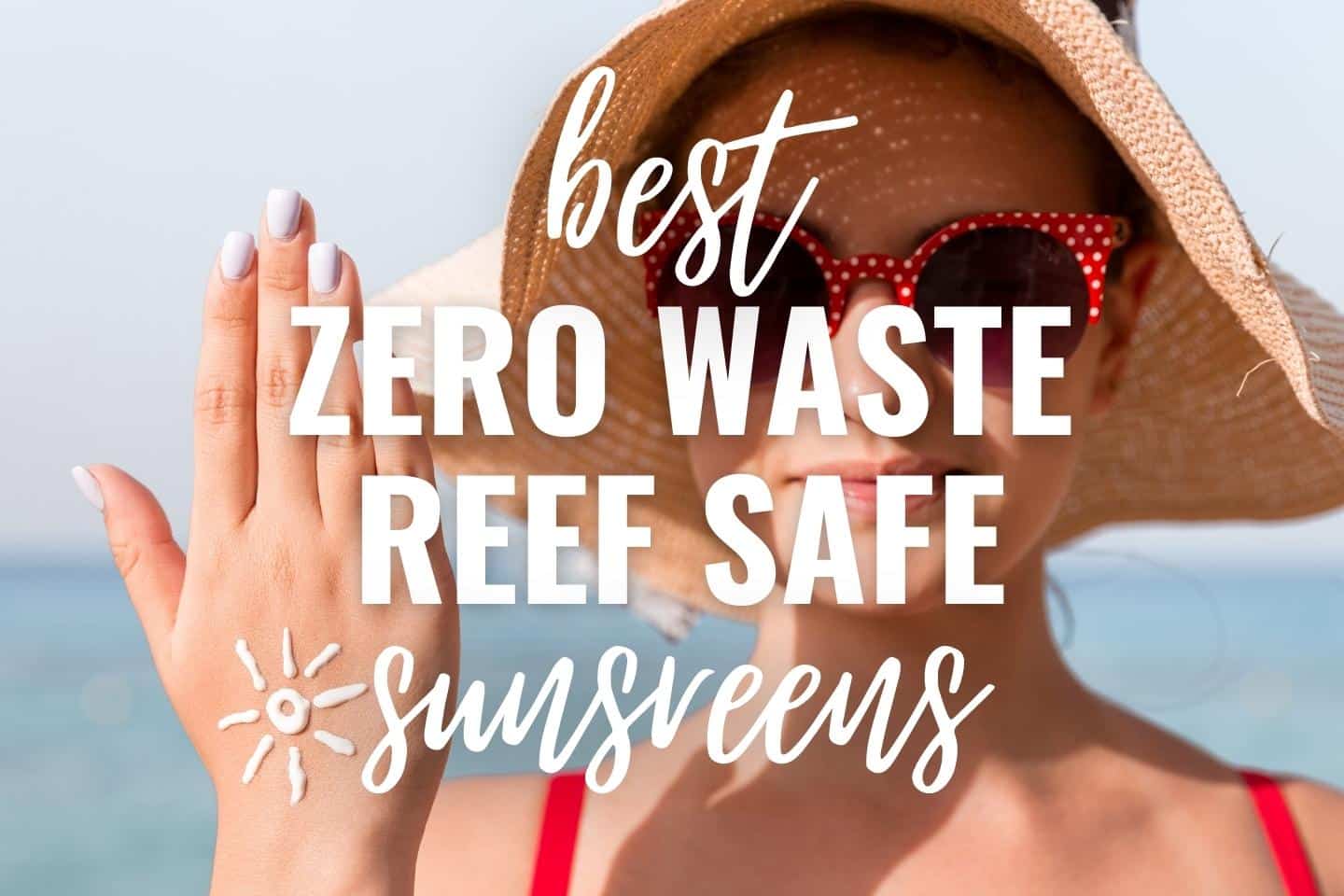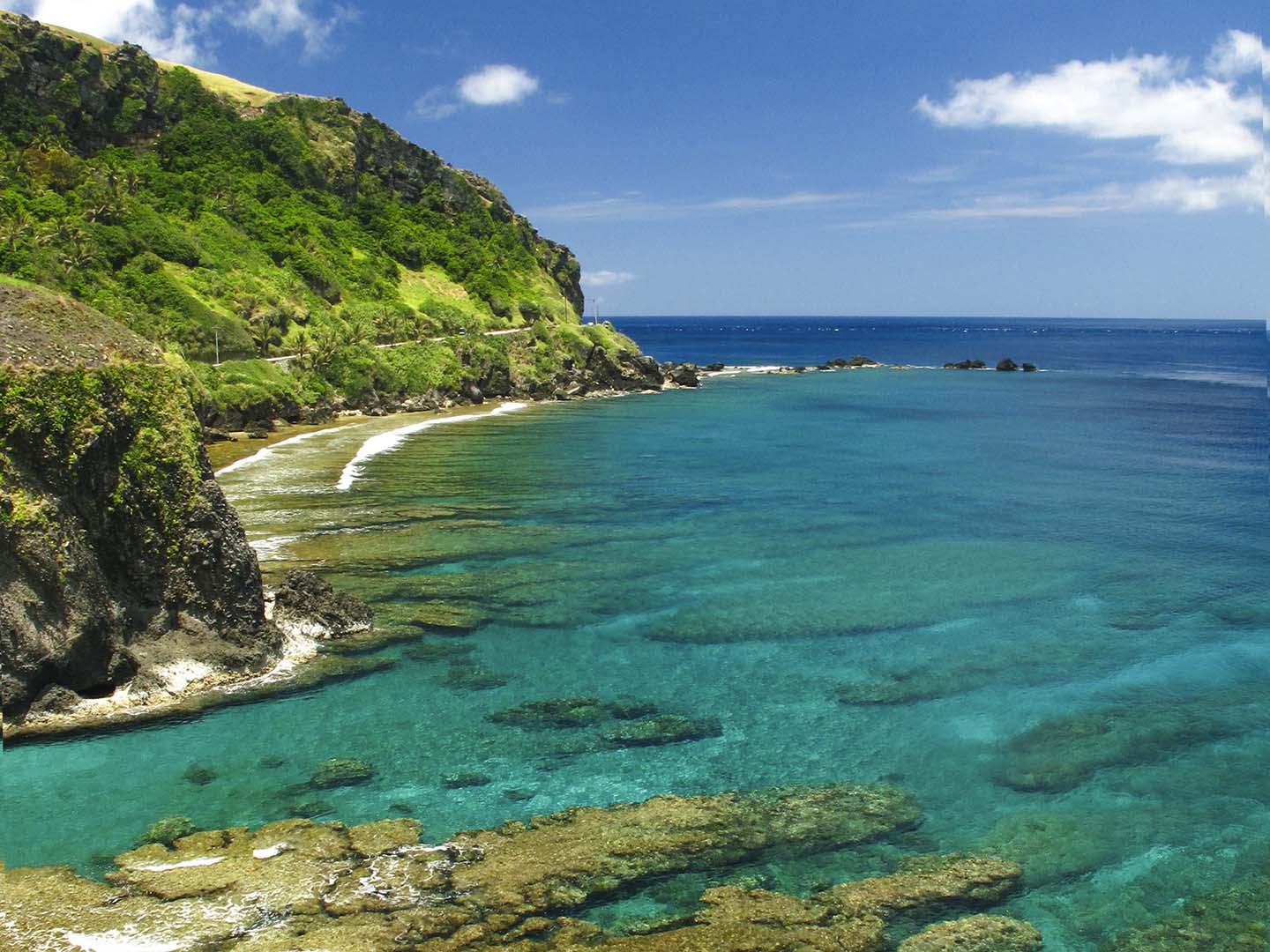After seeing the documentary Chasing Corals, I have made a more conscious effort to reduce my negative impact on the oceans. Upon hearing that my bottle of Coppertone was filled with chemicals that were harmful to corals, I immediately searched for an eco-friendly sunscreen alternative.
I discovered that there is such a thing as reef-safe sunscreen. So at that moment, I decided to never buy chemically-made sunscreen ever again.
The last reef-friendly sunscreen I bought was locally made. And while I was happy with the mineral-based sunscreen, I was not thrilled that it came in a plastic container. Here I was trying to help the ocean by using a “safe” sunscreen, yet it came in a single-use plastic tube that could potentially pollute it.
Turns out, I was not the only scuba diver and environmentally conscious consumer who saw the irony of this.
I knew there had to be a better way.
So I scoured the internet and I discovered zero waste reef safe sunscreen! This means that you can actually get your reef safe sunscreen plastic-free. Woo-hoo!
In my search for the best zero waste sunscreen, I narrowed it down to these three criteria:
- It does not contain any harmful chemicals.
- It is a mineral-based sunscreen.
- It has zero-waste packaging.
(I will expound on this later on.)
Luckily, I was able to find several ocean-friendly companies that were equally concerned about our planet as I was. You’ll be happy to know that there are amazing businesses out there who want to save our coral reefs too.
So, if you’re a scuba diver, surfer, ocean lover, or just a regular person who simply loves the environment, don’t worry there are toxic-free and eco-friendly sunscreens for you! Here are the 12 best zero waste reef safe sunscreens you will absolutely love:
- Raw Elements USA Sunscreen Tin
- Badger Clear Zinc Sport Sunscreen Tin
- Stream2Sea Sunscreen Bulk Size
- All Good Zinc Sunscreen Butter
- Manda Organic Sun Paste
- Raw Love Sunscreen
- Little Hands Hawaii Organic Mineral Sunscreen
- Surfdurt Sunblock
- Waxhead Tinted Surf Sunscreen
- SunButter Sunscreen
- Butter Me Up Organics Sunscreen
- Māmalu Liliko’i Mineral Sunscreen
Now, before you go on a shopping frenzy, it’s also important to understand why you should buy reef safe sunscreen and what makes sunscreen reef safe in the first place.
It’s important to educate yourself so you can educate others as well!
That being said, continue reading to learn more about zero waste reef safe sunscreens, and my top recommendations for the most ocean-friendly sunscreens.
Why is it important to use reef-safe sunscreen?
Back in 2015, a study was published on the toxicity of sunscreen to corals. It claimed that many over-the-counter chemical sunscreens contained ingredients that were causing distress to corals. When this happens, coral bleaching can occur.
Naturally, this discover raised alarms. After all, corals play an important role in our ocean’s ecosystems. Without them, many marine species will not have food, shelter, and a safe place to breed.
In response to this problem, environmentalists, particularly ocean lovers, advocated for consumers to make the switch to reef-safe sunscreen. Then, Hawaii banned the sales of chemical sunscreen that contained oxybenzone and octinoxate– the two recognized harmful ingredients in sunscreen.
While this may seem like it’s not a big deal, it is actually a big win for the ocean. This sparked a movement. It created awareness about the state of our coral reefs and the demand for ocean-friendly alternatives increased. Companies were forced to modify their sunscreen formulations, and brands had to come up with products that are “reef safe.” But what exactly does that mean?
What makes sunscreen reef safe?
Unfortunately, just because the label says it’s reef safe, it doesn’t necessarily mean that it is.
There are no regulatory boards that check if something is reef safe or not. Many stakeholders have set different standards as to what can be deemed reef-friendly. So before you trust the labels, you should check the ingredients listed on your sunscreen product.
I have seen so many brands peddling themselves as reef safe simply because they got rid of oxybenzone and octinoxate -the two main ingredients banned in Hawaii. But when you look at their ingredient list it’s been replaced with other chemicals and additives. And for me, that is just as bad.
As more and more experts research this problem, more chemicals are being recognized as harmful to the ocean. So which chemicals are not reef safe?
Sunscreen ingredients not reef-safe
Haereticus Environmental Laboratory, a non-profit scientific organization, came up with a list of chemicals that are known pollutants in many different environments. They call this the HEL list.
Based on rigorous scientific and environmental investigations, they have found that these chemicals pose a threat to the ecosystems and to wildlife. These harmful chemicals are:
- Oxybenzone
- Octinoxate
- 4-methylbenzylidene camphor
- Octocrylene
- Para-aminobenzoic acid (PABA)
- Methyl Paraben
- Ethyl Paraben
- Propyl Paraben
- Butyl Paraben
- Benzyl Paraben
- Triclosan
- Any form of microplastic sphere or beads.
- Any nanoparticles like zinc oxide or titanium dioxide.
I know that this list can be hard to remember so a good rule I follow: If I can’t pronounce the ingredients listed or it sounds too chemical, I just stay away from that sunscreen all together!
While there are many lists that are out there on what’s a good or bad ingredient for sunscreen, I opted to follow this list because of Haereticus Environmental Laboratory. As it turns out, they were involved in the study in Hawaii that revealed the toxicity of chemical sunscreen to corals.
HEL also does product testing on sunscreens to see if they are indeed reef-safe or not. In fact, two of the brands mentioned in this article, Badger and Stream2Sea were both certified reef-safe by Haereticus Environmental Laboratory based on these standards.
Sunscreen ingredients that are reef-safe
While zinc oxide or titanium dioxide are mentioned as harmful in the HEL’s list, these minerals can still be safe to use on sunscreen only if they are non-nano particles.
Non-nano sized means the particles are not extremely small. If the particles are Nano (smaller than 100 nanometers, or 100 billionths of a meter), they can be absorbed by corals and by your skin. That’s what you want to avoid.
By using non-nano sized zinc oxide or titanium dioxide minerals as an active ingredient, sunscreen becomes less harmful to ocean life and your body. So make sure that you choose reef-safe sunscreen that is made from NON-NANO minerals.
According to the FDA, titanium dioxide and zinc oxide are “generally recognized as safe and effective” or GRASE ingredients. Since it is FDA approved, it is common to see reef safe and mineral sunscreen manufacturers using either of these two in their formulations.
If you need a reef safe sunblock, look for a natural mineral sunscreen with non-nano zinc oxide or titanium dioxide as its active ingredient. This is the better alternative to chemical sunscreen because it is less harmful to the environment and your body.
Zero waste is also reef-safe
If you’re really concerned about the impact of your sunscreen on our ocean, it also makes sense to choose a reef safe sunscreen that comes in environment-friendly packaging.
Harmful chemicals aren’t the only problems plaguing our oceans today. Plastic trash is another major issue. You can also help the ocean by using less plastic and consuming less waste. By buying zero-waste sunscreen, you are helping save the ocean with one less plastic at a time.
Zero waste packaging means the product is in a container that won’t end up in our oceans or landfills. At the end of the product life, you should be able to easily reuse or recycle the packaging.
Best Zero Waste Reef Safe Sunscreen
Now that we’ve established what we are looking for in zero waste reef-safe sunscreen, let’s get into the pros and cons of each!
Here’s a table to summarize some of my findings!
[table id=7 /]1. Raw Elements USA Sunscreen Tin

Size: 3.0 oz / 85g
SPF: 35
Recommended reapplication: Reapply after 80 minutes of swimming, sweating or immediately after towel drying and at least every two hours.
Raw Elements Ingredients: Non-Nano Zinc Oxide (23%), Sunflower Oil, Green Tea, Black Tea, Coffee Bean, Hemp Seed Oil, Cocoa Butter, Mango Butter, Beeswax, Rosemary Oil Extract, Vitamin E
Packaging Materials: reusable and recyclable metal tin can
About the brand making this plastic free reef friendly sunscreen:
Raw Elements was founded by Brian Guadagno, an ocean lifeguard, who has spent hundreds of hours under the sun. Upon discovering how harmful chemical sunscreens are for the oceans and his health, he sought to find a safe and effective alternative. Having found none that fit his lifestyle and needs, he began formulating his own natural sunscreen in his lab, aka his kitchen! He realized that so many other people needed access to a healthier and better sunscreen and so Raw Elements USA was born.
Fun fact: In their commitment to sustainability, Raw Elements USA also founded World Reef Day on June 1st, 2019.
What else you’ll love about this plastic free reef friendly sunscreen:
- 1% For The Planet business member which means they donate 1% of annual sales to environmental non-profits
- Certified Natural by The Natural Products Association, Certified Non-GMO by Non-GMO Project, Certified Cruelty-free by Leaping Bunny
- Sunscreens are now also available in recyclable aluminum tubes
- They have other reef safe products that are great gifts for environmentalists
What you might NOT like:
- while they say they follow the Haereticus Environmental Laboratory guidelines, they are yet to be certified
2. Badger Clear Zinc Sports Sunscreen Tin
Size: 2.4 oz / 68 grams
SPF: 40 broad-spectrum protection from UVA and UVB rays
Recommended reapplication: Up to 80 minutes of water and sweat resistant sun protection
Badger Sunscreen Ingredients: Uncoated Zinc Oxide 22.5%, Organic Sunflower Oil, Organic Beeswax, Sunflower Vitamin E
Packaging Materials: recyclable or reusable tin
About the brand making this plastic free sunscreen:
Badger is a small family-owned, family-run company based in Gilsum, New Hampshire. The company was started by Bill Whyte in 1995 after creating a balm that helped his cracked hands during the cold winters. To date, using the finest organic plant extracts, exotic oils, beeswax and minerals, Badger has created over 100 products that soothe, heals, and protect the body. The company has grown to over 80 employees who formulate, create, and ship their products around the country and to the rest of the world. Badger became a B-Corporation that is committed to doing what’s right for people and the planet.
What else you’ll love about this plastic free sunscreen:
- Uses just 4 ingredients that are safe for your skin and for the reef
- Lightweight and moisturizing so it’s easy to apply and blend with any skin tone
- No added fragrance
- Reef-friendly sunscreen that is Protect Land + Sea Certified by the Haereticus Environmental Laboratory. See Badger Test results here.
What you might NOT like:
- small volume might not be enough for long travel hauls
3. Stream2Sea Sunscreen Bulk Size

Size: 32 oz / 907 grams
SPF: 30
Recommended reapplication: Reapply after 80 minutes of swimming, sweating or immediately after towel drying and at least every two hours.
Stream2Sea Sunscreen Ingredients: Deionized Water, Aqueous Extracts of Camellia Sinensis (Green Tea) Leaf*, Ocimum Tenuiflorum (Tulsi) Leaf*, Alaria Esculenta (Wakame Seaweed)* and Olea Europaea (Olive) Leaf*, Caprylic/Capric Triglyceride, Aloe Barbadensis (Aloe) Leaf Juice*, Cocoglycerides, Glycerin, Cetearyl Alcohol, Cetyl Palmitate, Polyhydroxystearic Acid, Sorbitan Olivate, Cetearyl Olivate, Methylcellulose, Cocos Nucifera (Coconut) Oil*, Stearic Acid, Acrylates Copolymer, Magnesium Aluminum Silicate, Sorbitan Palmitate, Tocopherol, Xanthan Gum, Alumina, Benzyl Alcohol, Salicylic Acid, Sorbic Acid. *Certified Organic
Packaging Materials: Comes in recyclable plastic made from recycled milk gallon containers and plastic water bottles
About the brand making this sustainable reef safe sunscreen:
Stream2Sea was founded in 2015 in Wauchula, Florida by a fellow scuba diver, Autumn Blum. After a dive trip to Palau she realized that the products we were using had many ingredients that could be highly toxic to us and the fragile aquatic ecosystem. Teaming together with other environmentally conscious individuals, Stream2Sea creates sustainably made sunscreen for scuba divers, kayaker, swimmers, hikers, campers, skiers, and basically any outdoor enthusiast on the planet.
What else you’ll love about this sustainable reef safe sunscreen:
- Tested and proven safe for baitfish, freshwater fish, saltwater fish and coral larvae and does not affect their natural behavior
- Bulk sizing is great for individuals who are out in the sun often.
- Also great for sharing among families or small businesses (ex. dive shop, surf shop, resorts)that want to offer reef-safe sunscreen to employees and guests
- Economical to purchase in bulk but also available in smaller sizes
- Protect Land + Sea Certified by the Haereticus Environmental Laboratory. See Stream2Sea Test results here.
What you might NOT like:
- while packaging uses recycled plastic, it is still not completely plastic free
Get a 10% discount on Stream2Sea when you use my special code: DIVERBLISS
4. All Good Zinc Sunscreen Butter

Size: 1 oz / 28.35 grams
SPF: 50+ UVA/UVB broad-spectrum protection sunscreen
Recommended reapplication: Sun protection up to 80 minutes.
All Good Sunscreen Ingredients: Made with USDA Certified Organic Ingredients- Zinc Oxide 25% (Non-nano particle), Organic Cocos Nucifera (Coconut) Oil, Organic Cera Alba (Beeswax), Organic Calendula Officinalis (Calendula) Flowers infused in Organic Simmondsia Chinensis (Jojoba) Seed Oil, Non-GMO Tocopherol (Vitamin E)
Packaging Materials: Reusable and recyclable metal tin
About the Brand making this zero waste reef safe sunscreen:
All Good was started decades ago by Caroline Duell who made plant-based hand salves for climbers, farmers and makers. Her products were “all good” that they expanded their collections and their business to what it is today. Through the years they have stuck with their philosophy of making products that are good for the people, the community and of course the environment from where everything is sourced.
All Good is based in Morro Bay, California. They have an organic farm where they grow herbs for the products. Then they make their products in their solar-powered kitchen! When possible, they use recycled or recyclable packaging, shipping, and printing materials. All Good is also a 1% For the Planet Member.
What else you’ll love about this zero waste reef safe sunscreen:
- Perfect size to keep in your bag or pocket so you can apply anytime and anywhere, definitely worth including in your zero waste travel kit!
- Contains mineral iron oxides that create a neutral tint that works with most skin tones
- Leaping Bunny Certified cruelty-free
What you might NOT like:
- small volume might not be enough for long travels or for full-body coverage
5. Manda Organic Sun Paste

Size: 1.4 oz / 40 grams
SPF: 50
Recommended reapplication: Up to 4 hours
Manda Sunscreen Ingredients: Non-nano zinc oxide – 20%, Organic Coconut Oil, Organic Beeswax, Organic Cocoa Butter, Thanaka, Organic Cacao Powder, Organic Shea Butter, Organic Cinnamon Oil
Packaging Materials: recyclable and reusable bamboo and tin container
About the brand making this eco-friendly sunscreen:
MANDA was founded by two dudes who love to surf. As outdoor lovers, Cyrus Sutton and Reis Paluso wanted a good sunscreen that would last in different conditions. They wanted a sunscreen that could withstand the rigors of the outdoor lifestyle. But as family-men, they also wanted something safe and gentle enough for their babies and toddlers. Because of their love of being in the sun and having witnessed a family member’s near-death experience from skin cancer, they created Manda- a high-performing, organic, sustainable sunblock.
What else you’ll love about this eco-friendly sunscreen:
- Made with Thanaka – wood used for over 2000 years by Burmese people to protect and beautify the skin. Thanaka provides natural sun protection, is high in antioxidants, is regenerative, and has anti-bacterial, anti-fungal, anti-acne, and anti-aging properties
- specially designed for surfers, climbers, hikers, athletes, adventurers, or anyone who loves to be outside or in the water
- Updated packaging now includes a mirror inside the cap for easy application
What you might NOT like:
- price per ounce is on the high-end price range
6. Raw Love Sunscreen

Size: 2 oz / 56.7 grams
SPF: 35
Recommended reapplication: Reapply at least every 2 hours and after 40 minutes of swimming or sweating, and immediately after towel drying.
Ingredients: Cold Pressed unrefined coconut oil, Raw Shea Butter, Zinc Oxide ( non nano), Sesame Oil Beeswax, Jojoba Oil, Vitamin E Oil, Sunflower Seed Extract, Carrot Seed Oil, Pure Essential Oils: Lavender, Peppermint, Eucalyptus
Packaging Materials: Recyclable Metal Tin
About the brand making this plastic free reef safe sunscreen:
Raw Love is a sunscreen brand developed by fellow scuba diver, Jenna Davis. As a PADI divemaster and SNUBA instructor in Maui, Hawaiʻi, she knew the importance of wearing sunscreen to protect her skin while protecting the reef. Combining her past studies in marine biology and months of research and trials, Jenna was able to formulate an eco-friendly, biodegradable, moisturizing mineral sunscreen. Using high-quality ingredients she developed a sunscreen safe for the entire family.
What else you’ll love about this plastic free reef safe sunscreen:
- uses 100% all natural plant-based ingredients using organic farming methods
- hand-selected ingredients to give your skin and/or tattoos the moisture, antioxidants and glow that you deserve!
- FDA approved
What you might NOT like:
- gender specific branding, product seems targeted for women… but might still be perfect as a gift for women divers!
7. Little Hands Hawaii Organic Mineral Sunscreen

Size: 3.4 oz / 96.4 grams
SPF: SPF35
Recommended reapplication: Water resistant for up to 80 minutes
Little Hands Hawaii Sunscreen Ingredients: Non-Nano Zinc Oxide, Organic Coconut Oil, Organic Jojoba Oil, Shea Butter, Local Beeswax, Vitamin E Oil, Elderberry and Frankincense Essential Oil
Packaging Materials: Recyclable / reusable 2-oz tin can, also available in 1 oz carton tube
About the brand making this plastic free sunscreen:
Little Hands Hawaii is a sunscreen brand that began because of a mother’s love for her daughter. In 2011, first-time mom, Rosalyn, could only find chemical-filled sunscreens in a health store. She was surprised to see that everything on the shelf was loaded with harmful ingredients. As a mother and a registered nurse, she knew she did not want to expose her newborn baby to that. Wanting only the best for her family, she created her own sunscreen made with organic and naturally sourced ingredients. Eventually, family, friends, and retail outlets in Hawaii wanted her baby-safe and reef-safe sunscreen and so Little Hands Hawaii was born.
What you’ll love about this plastic free sunscreen:
- Safe for marine life and your entire family
- Ingredients are sourced from Hawai’i
- handmade by Hawaiians in compliance with FDA
What you might NOT like:
- marketed as a family-friendly brand but only comes in 3.4 oz or smaller sizes
8. SurfDurt Sunblock

Size: 2 oz / 56.7 grams
SPF: SPF 30
Recommended reapplication: water-resistant up to 80 minutes
SurfDurt Sunscreen Ingredients: Non-Nano Zinc Oxide, Cocoa Butter, Coconut Oil, Jojoba Oil, Avocado Oil, Beeswax, Beeswax Derivative, Mango Butter, Vitamin E, Iron Oxide Pigment
Packaging Materials: Recyclable / reusable 2-oz tin can
About the brand making this plastic free sunscreen:
SurfDurt Sunscreen was founded by 2 women, Maxine and Nicolette. As native Californians who love the outdoors and surfing, they knew they needed sunscreen to protect themselves from the harmful rays of the sun. They found themselves smearing chemical sunscreen on their faces that would cause their eyes to sting and cause acne breakouts. Then after discovering that most sunscreens were toxic to coral reefs, they knew there had to be a better way. With the help of Maxine’s Dad who was a chemist and surfer, they formulated the non-nano zinc oxide Surfdurt sunscreen.
What you’ll love about this plastic free sunscreen:
- Uses tons of antioxidants and high-quality natural ingredients
- Cocoa Scent
- Available in Tan tint
What you might NOT like:
- Does not specify if FDA approved
9. Waxhead Tinted Surf Sunscreen

Size: 2 oz / 56.7 grams
SPF: 30
Recommended reapplication: Re-apply every 2 hours
Face The Vibes Sunscreen Ingredients: 25% non nano zinc oxide, coconut oil, beeswax, cocoa powder
Packaging Materials: Tin
About the brand making this reef safe, plastic free sunscreen:
Waxhead was created by native Floridian and mom, Kari Kenner, who wanted her boys to be safe in the sun. After looking more closely at commercial sunscreens, she noticed that almost every big brand of sunscreens relied on toxic ingredients – hazardous to both humans and marine life.
As she and her husband, Shannon talked, they decided to start Waxhead. Their philosophy is to get modern people outdoors again, using traditional ways as inspiration for four modern strategies to thrive in the sun.
What else you’ll love about this reef safe, plastic free sunscreen:
- safe for babies to adults – built for sensitive skin
- Scored #1 by the EWG Sunscreen Guide
- won’t sting eyes or run and gives true UVA UVB coverage
- Cruelty free, gluten free, non-greasy, and hypoallergenic
- 80-minute water-resistance standard
What you might NOT like:
- thick consistency might be hard to apply
10. SunButter Sunscreen
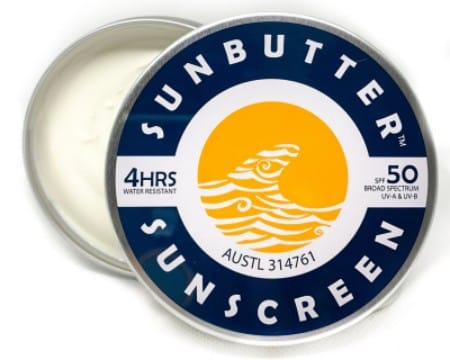
Size: 3.53 oz / 100g
SPF: SPF 50
Recommended reapplication: water-resistant up to 4 hours
SunButter Sunscreen Ingredients: Non Nano Zinc Oxide, Median chain triglyceride (from coconut oil), Candelilla wax, Coco-caprylate (from coconut oil), Castor Oil, Coconut Oil, Polyglyceryl-3 polyricinoleate (vegetable based emulsifier), Isostearic acid (plant based binder), Tocopheryl acetate (Vitamin E)
Packaging Materials: Recyclable / reusable tin can
About the brand making this zero waste reef safe sunscreen:
In 2016, marine biologist and conservation ecologist team Sacha Guggenheimer and Tom Hiney, developed SunButter™ after learning about the negative impacts of chemical sunscreen on our coral reefs. Because they were working in Ningaloo Reef in Western Australia, they were torn between the need to wear sunscreen and their passion for protecting the world heritage site. This paved the way for developing a natural, high-quality zero waste reef safe sunscreen. The original SunButter sunblock was handmade for the whale shark guides, photographers, spearo’s, divers and fisherman of the Ningaloo Reef. They have now expanded their product portfolio since and now ships world wide.
What you’ll love about this zero waste reef safe sunscreen:
- Australia’s only TGA approved plastic free sunscreen
- water-resistant for up to 4 hours
- Gentle formula is vegan, palm oil free and reef safe
What you might NOT like:
- Product is shipped from Australia and might have some shipping issues
11. Butter Me Up Organics Sunscreen
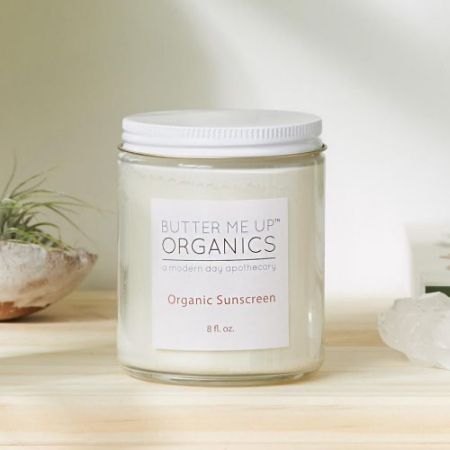
Size: 8 oz / 226.8 grams
SPF: 45
Recommended reapplication: Lasts up to 3 hours.
Butter Me Up Organics Sunscreen Ingredients: Coconut Oil, Shea Butter, Mango Butter, Non-Nano Zinc Oxide, Non-GMO Grapeseed Oil, Vitamin E, Beeswax
Packaging Materials: Reusable glass jar
About the brand making this zero waste sunscreen:
Butter Me Up Organics is a zero waste company that produces organic and sustainable bath, body, baby, and home products. Founded by Jillian Haddad in 2008, Butter Me Up Organic believes in using the best ingredients that are safe for your body and the environment. All of their products are in glass, tin, or paperboard and they ship 100% plastic free.
What else you’ll love about this zero waste sunscreen:
- Comes in various sizes (2, 3, 4, and 6 ounces also available)
- Easily absorbed by the skin and does not leave a white tint like most zinc oxide sunscreen
- Uses organic shea butter, mango butter and coconut oil leaving your skin feeling soft and smelling great
- best value for money- cost per ounce is lowest compared to others on the list
What you might NOT like:
- not FDA approved yet
12. Māmalu Liliko’i Mineral Sunscreen
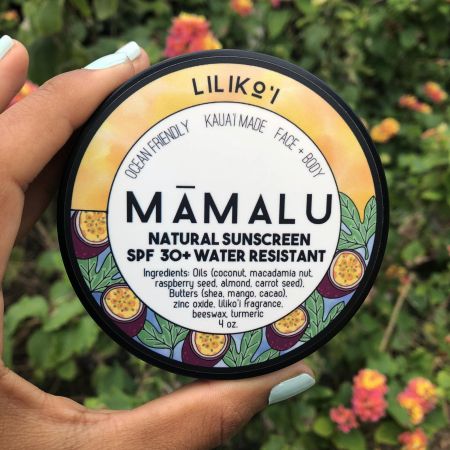
Size: 4 oz / 113.4 grams
SPF: SPF30
Recommended reapplication: Re-apply every 3 hours
Mamalu Liliko’i Sunscreen Ingredients: Organic Coconut oil, Organic macadamia nut oil, raspberry seed oil, carrot seed oil, almond oil, shea butter, mango butter, cacao butter, local Hawaiian beeswax, non-nano zinc oxide, turmeric, liliko’i fragrance
Packaging Materials: Reusable metal tin can, shipped in compostable bubble wrappers
About the brand making this ocean-friendly sunscreen:
As a mom of an active toddler growing up in beautiful Hawaii, Fallon Mann knew staying out of the sun is not an option. So she created Māmalu- a sunscreen that heals and nourishes the skin while providing powerful sun protection for you and your family. Her sunscreens are made of high-quality, locally sourced ingredients and will give you scents, or rather, a sense of Hawaii.
What else you’ll love about this ocean-friendly sunscreen:
- perfect for water activities as it is water-resistant and won’t sting eyes
- can also be used for kids
- smells amazing and also available in other scent variations of Mint Chocolate and Kōkeʻe (an intoxicating woodsy, floral scent)
What you might NOT like:
- not FDA approved yet
You may also check out these sustainable online stores that sell zero waste sunscreen:
USA: EarthHero | EcoRoots | Life Without Plastic | Zero Waste Store | Well Earth Goods
Canada: Bare Market
UK:A Waste Free World
Australia: Dirty Hippie Cosmetics
Philippines: Human Nature
For more recommendations, you may also search my List of Zero Waste Stores Online to find the best eco-friendly shop nearest you.
How to choose the best zero waste reef-safe sunscreen for you
While I have my top choices for the best zero waste reef safe sunscreen, I recommend that you choose one that fits your needs and lifestyle. Here are some tips to help you choose the best reef safe sunblock for you.
1. Always check the listed ingredients
As we’ve established earlier on, always check the ingredients first. Do not trust the label even if it says “reef-safe” or “reef-friendly.” Avoid any of the harmful chemicals and instead, stick to natural mineral sunscreens made from non-nano zinc oxide or titanium dioxide.
You should also check the rest of the ingredients that were used to make your ocean-friendly sunscreen. Most manufacturers will add many organic, natural, and biodegradable ingredients, which are great. But do your due diligence and check if there are some that you might be allergic to. You can also find out if the ingredients were sustainably sourced.
2. Understand what Broad Spectrum and SPF are
While you want the best sunscreen that will not harm corals, you’d also want to choose one that won’t harm you. When choosing sunscreens you’d want a product that offers you the right protection for your skin. You want to get something that has a broad spectrum. This means that the sunscreen is able to protect you from the two types of UV radiation- UVA and UVB.
Mineral-based reef-safe sunscreens can provide you broad spectrum protection because they work by creating a physical barrier on the skin. Mineral sunscreens, also known as physical sunscreens, stay on the skin’s surface. It protects you by deflecting the sun rays rather than absorbing them. This is what makes mineral, reef-safe sunscreens very effective in skin protection.
While mineral sunscreen block out both UVA and UVB rays, it cannot block UV rays 100 percent. This is where Sun Protection Factor or SPF comes in. The SPF is a good indicator of how much of the UVB rays are blocked. The table below shows how much of the UVB Rays are blocked for each SPF number.
| SPF | Percentage of Blocked UVB Rays |
| SPF 15 | 93% |
| SPF 30 | 97% |
| SPF 50 | 98% |
| SPF 100 | 99% |
For most people and skin types, SPF 30 will give you enough protection from the sun. Of course, you can go higher as every extra percent of sun protection will be beneficial. If you are spending a lot of time in direct sun, then it definitely won’t hurt to put on sunscreen with a higher SPF number.
Just remember that a higher SPF does not mean you are protected for a longer period of time. It just means that more UV rays are being blocked out when your sunscreen is working at its maximum efficiency. When applied correctly, this is usually for 2 hours. So make sure to reapply sunscreen often to avoid getting sunburnt.
3. Consider additional product features
Many mineral sunblocks are known to give a white cast on your skin which can be a big turn-off for some people. To address this concern, many brands offer tinted reef-safe sunscreens so you don’t look like a ghost while you’re out and about.
Another feature that you might want to have is the scent. How the sunscreen smells can be a huge selling point for many consumers. Especially when you need to sunscreen frequently on your face, you might want something that isn’t too overpowering.
Don’t forget to read the product reviews to find out more about the sunscreen feature and user experience. Feedback from users are very helpful in determining what else you can love or hate about sunscreen.
4. Learn about the company behind it
Aside from the product itself, you might want to find out about who makes your products and how they make your products. There are many companies out there who care nothing but making a profit. And while this is not necessarily bad, wouldn’t it be better to support a business whose values align with yours?
Is their business really sustainable? Are they an ethical company? Are they really who they claim they are? What are their customers saying about them?
If these things are important to you, take those extra steps to find out if the brand you chose is someone you’d want to support. After all, it is only fair that you give your hard-earned money to someone who not only can be trusted but can also do good.
5. Check on certifications
Companies can use certifications to prove who they say they are. By submitting their product for testing, they get a certification to prove any claims they have. Some companies will have several certifications under their belt while others will have none.
Is it important to you if a sunscreen brand is animal cruelty-free, certified vegan, certified non-gmo, or certified organic? For some people, these are not necessary but for others, it helps them in the buying process.
6. Choose waste-free packaging
While this list of eco-friendly sunscreen has been narrowed down for you, you should also consider how you’ll dispose of your packaging when you’ve used up all the sunscreen. Yes, these zero waste sunscreen packaging can easily be reused and recycled. But you should consider if it will be easy for YOU.
Are there facilities in your area that can easily recycle? Will you actually be able to reuse the packaging? A good zero waste practice is to consider what you will do to the container when you’ve used up all the sunscreen.
If you want to further reduce your consumption and waste, you should also consider how your plastic-free sunscreen will be shipped. Will the company be able to ship plastic-free or will it be packed in bubble wrap and plastic?
7. Support local businesses
If you want to further help the environment, choose a plastic-free sunscreen that can be bought locally. Check with your local dive or surf shop if they have one. Or buy it from your favorite zero waste shop in your neighborhood.
If you have no choice but to have it shipped to you, buy from somewhere close. Avoid having to order from somewhere across the world. Not only will it save you money and help the local economy, but doing these small things can reduce your carbon footprint.
Do you love supporting local businesses? Check out my list of ocean companies making a difference in their own communities.
How to properly apply zero waste reef-safe sunscreen
Once you’ve purchased your eco-friendly sunscreen, you would want to enjoy the full benefits of it by using it properly. I have seen many product reviews with claims that the reef-friendly sunblocks don’t work. My guess is that they just didn’t use the sunscreen correctly!
So here are some tips on how to apply your zero waste reef-safe sunscreen to your skin.
- Apply sunscreen at least 20 minutes before you step out under the sun. This should allow the sunscreen to set and dry. The sun will start to burn you as soon as you step out so protect your skin immediately! Don’t wait until you’re already starting to turn pink.
- Using your fingers and your palm, rub the reef-safe sunblock thoroughly onto your skin. One technique you can try is to dab small amounts of sunscreen across your skin and spread evenly.
- Depending on the formulation, some reef-safe sunscreen can sometimes feel more gritty and thick. Sometimes it can have a consistency of a paste rather than a lotion. This can be frustrating for some people so just be patient.
- Apply your reef-safe sunscreen in layers. If you’re prone to burn more in some areas of your body, go back to those delicate spots and apply again. I usually do this on my face, my chest, shoulder, and back.
- Grab a mirror or ask a friend to help you. It’s very important that you put sunscreen on every inch of exposed skin.
- Reapply every 2 hours. But if you sweat more or get in the water, reapply every 80 minutes. Every time you towel off, you could be removing some of the sunblock so reapply right after. While this is the rule of thumb, if you’re doing extreme activities and feel the need to reapply, then don’t hesitate to do so. Basically, don’t be lazy.
- Take extra precautions by seeking shade when the sun is at its peak. This is usually from 10 am to 4 pm. You can also wear extra cover-up and clothing protection so you don’t have to apply sunscreen on every part of your body. You can get a lightweight long-sleeved shirt, wear a sarong, put on a wide-brimmed hat and sunglasses, or wear a neck gaiter to protect your skin.
Pro-tip: If you are in the ocean and under the sun often, invest in clothing with UPF-rating. Instead of applying reef-safe sunscreen all over your body, you can wear rash guards and dive leggings. These will protect most of your skin while diving and snorkeling. Only apply reef safe sunscreen on your face and other exposed area.
(UPF rating is similar to SPF but it measures the effectiveness of clothing or fabric in filtering UV rays of the sun.)
Frequently Asked Questions about Reef Safe Sunscreens
How do I know if the sunscreen I am using is reef-safe?
The best way to determine if sunscreen is reef safe or not is by always checking the ingredients. If it contains chemicals like Oxybenzone and Octinoxate you should immediately avoid those. While these two are the most commonly known harmful sunscreen ingredients there are many more other chemicals that you should avoid. Your best solution is to find a mineral sunscreen made from non-nano zinc oxide or titanium dioxide.
Is reef-safe sunscreen effective in sun protection?
Yes, reef-safe sunscreen is very effective against the harmful rays of the sun. The reef-safe sunscreen, which uses non-nano zinc oxide or titanium dioxide as its active ingredient, works as a physical barrier between your skin and the UV rays. When applied correctly, reef-safe sunscreen can prevent skin damages like dryness, sun spots, wrinkles, and sunburn.
Is reef-safe sunscreen safe for children?
Yes, reef-safe sunscreen is safe for children. Many manufacturers use natural and organic ingredients as part of their formulation so they are definitely more safer than chemical sunscreens. It is recommended though that you check the ingredients in case your child has allergies. You can also do a patch test to ensure that your child does not have an allergic reaction to the reef-safe sunscreen. For babies under six months old, always consult your doctor first.
Should I use reef-safe sunscreen even if I am not going to the ocean?
You should use reef-safe sunscreen as often as you can because it is good for your health and good for the environment. Dermatologists recommend that you should wear sunscreen every day to protect your skin from the damaging rays of the sun. This should be part of your skincare routine as a preventive measure against skin conditions like premature skin aging, sunburns, and even skin cancer. You should consider switching to reef-safe sunscreen as it is a good alternative to chemical sunscreens.
Even if you don’t intend to swim in the ocean or spend the day at the beach, you should choose reef-safe sunscreen because it matters to the environment. Remember that whatever goes down the drain can eventually make its way to rivers, streams, and oceans. So when you are rinsing off the chemicals from your body, it can pollute nature and then make its way to the ocean.
What’s the best way to remove reef-safe sunscreen from my skin?
Reef-safe sunscreen is water-resistant so it is normal to be left with a layer of coating on your skin after a fun day under the sun. To remove reef-safe sunscreen on your face, you can first massage some oil onto your skin. Coconut oil, olive oil, jojoba oil, sunflower oil, and similar natural oils can be used. Micellar water has also been proven to be effective. While the oil works its wonders, grab a washcloth and dampen it with warm water. Then, wipe away the remaining oil and sunscreen from your face. Finally, wash your face with warm water and facial soap.
For the rest of your body, you can use warm water and soap to remove the reef-safe sunscreen. You can also use a body scrub or loofa to clear your skin from the mineral sunscreen.
Does reef-safe sunscreen expire?
Reef-safe sunscreen does expire. You can expect it to spoil and go bad eventually. Once it expires, you should not use it. Expired sunblock becomes less effective and can result in sunburns and other skin problems. Always check with the manufacturer how long the sunscreen shelf-life is and how to properly store your sunscreen.
Why did I still get a sunburn after using reef-safe sunscreen?
There could be several reasons why you got sunburnt despite using reef-safe sunscreen. Here are some of the things that could have gone wrong.
1. You did not apply it correctly. If you didn’t apply enough or apply it evenly then you will not enjoy the benefits that sunscreen provides.
2. You forgot to reapply sunscreen. It is recommended that you reapply sunscreen every two hours. You must also reapply after swimming or sweating. Reef-safe sunscreen can be washed or rubbed off from the skin from physical activities making it less effective.
3. You used an expired reef-safe sunblock. Sunscreen should be stored properly and used before its expiration date for maximum efficacy.
To avoid getting sunburnt, read and follow instructions provided by your preferred reef safe sunscreen brand.
Pin this article or share it with a friend
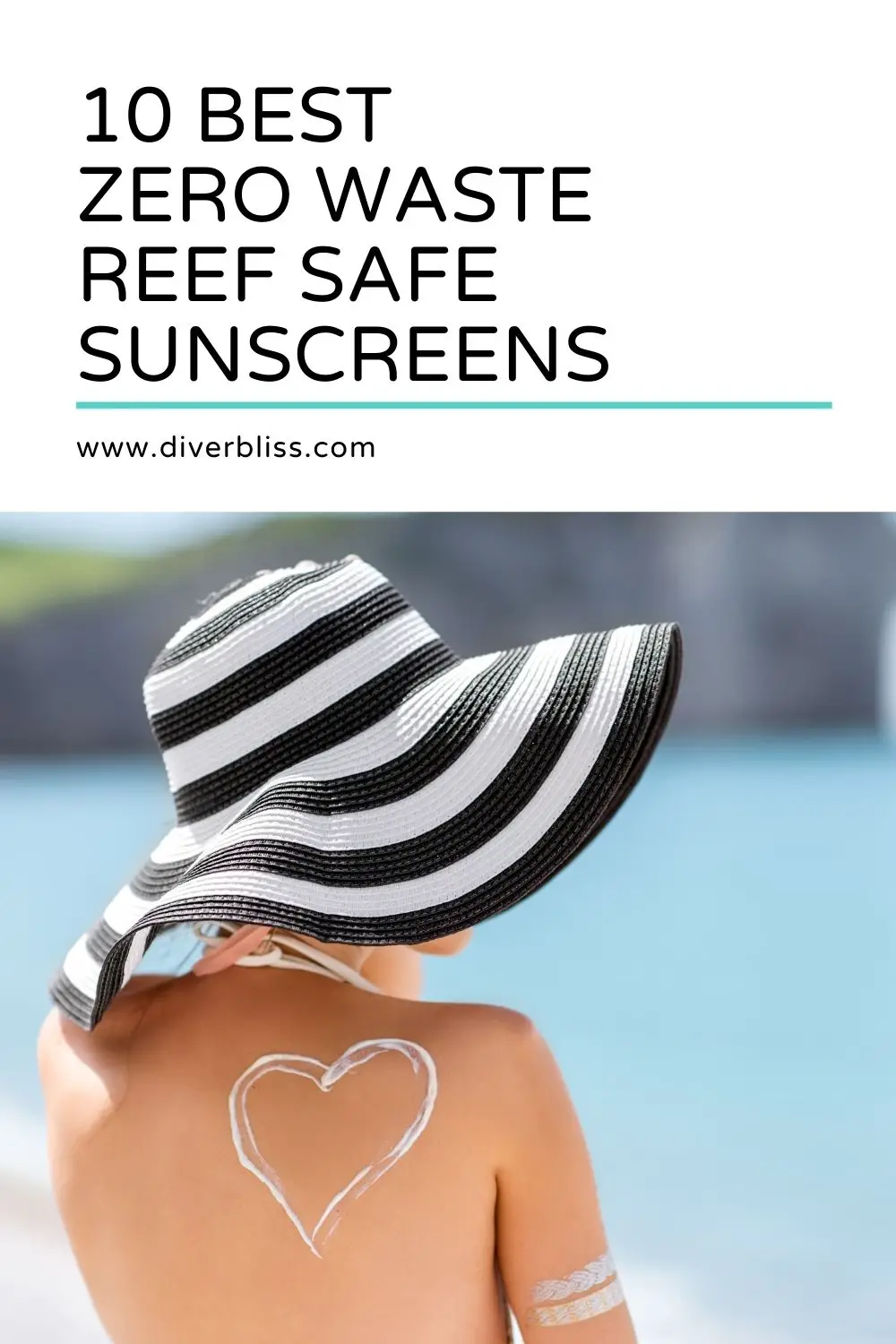
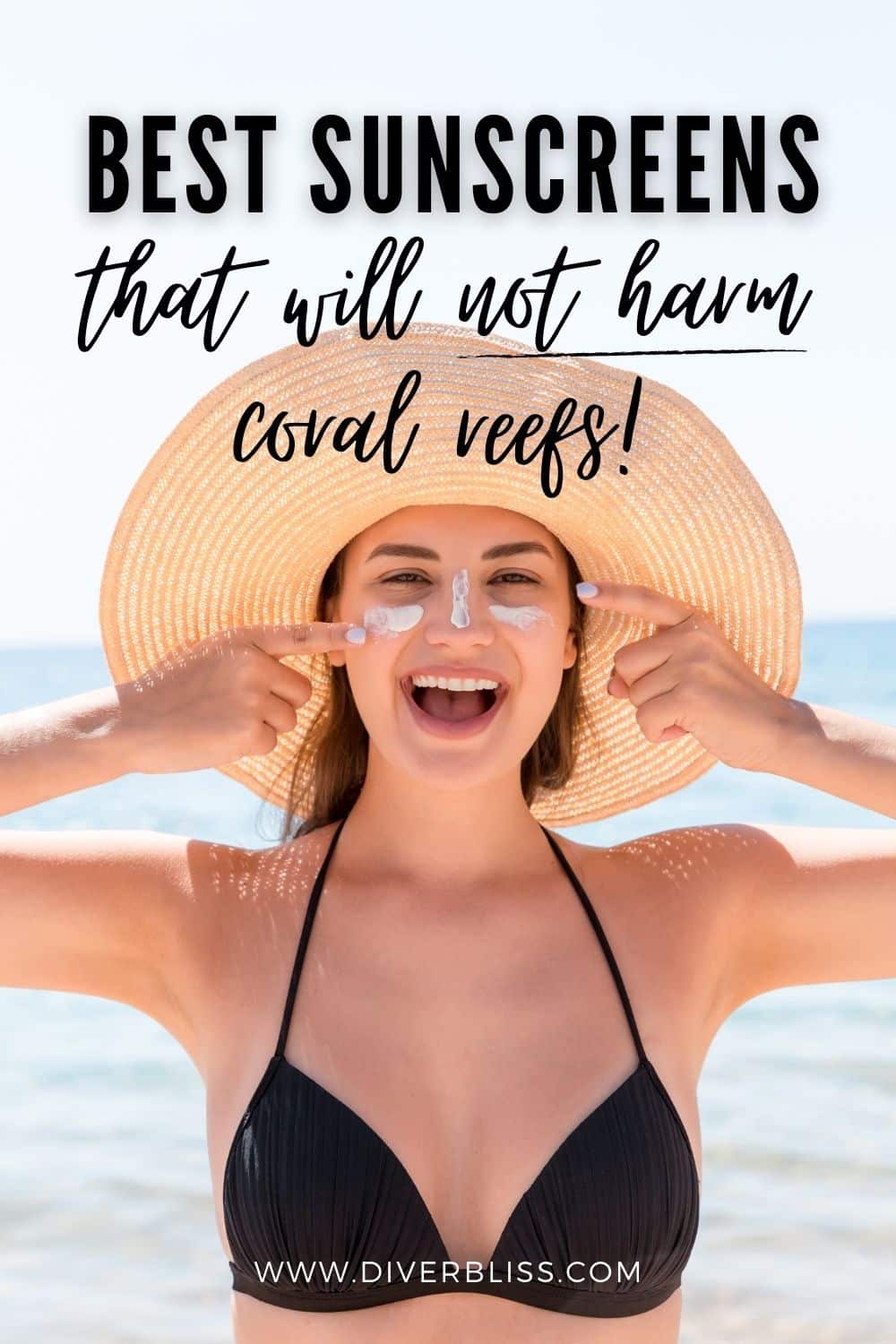
Now that you know more about these ocean-friendly alternatives, will you dare to make the switch?
If there are sunscreen options that are deemed to have less impact on the environment, then what’s stopping you from choosing the better alternative? If there are sunscreens that have fewer chemicals in them, then why wouldn’t you use the more natural option for your body? Now is a good time to make that easy zero waste swap.
Do yourself a favor and get yourself the best sunscreen for the environment and for you.
To end, I will leave you with this famous song.
More than two decades later from when this was released, the advice is still applicable today. I would just update it to: Wear REEF SAFE Sunscreen!
Will you make the switch and now use reef safe sunscreen that’s also plastic-free? What zero waste reef safe sunscreen do you want to try? What makes you want to use zero waste reef safe sunscreen? Leave a comment below!
Zero waste and eco-friendly guides you might want to read:
60+ Best Online Zero Waste Stores and Eco-friendly Shops
45 Easy Zero Waste Swaps for a Plastic Free Life
15 Best Zero Waste Starter Kits and Bundles
21 Zero Waste Travel Essentials
101 Ways to Say No To Plastic
Best Zero Waste Subscription Boxes
Best Zero Waste Reef Safe Sunscreen
Best Zero Waste Shampoo and Conditioners
Best Eco-friendly Hair Brushes and Combs
Best Zero Waste Period Products
Amazing Ocean Companies Saving Our Seas
10 Saving the Ocean Bracelets
27 Best Environmentalist Gifts: What To Get An Eco-friendly Person
